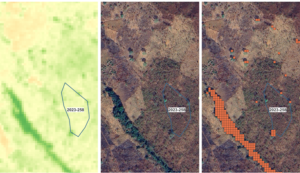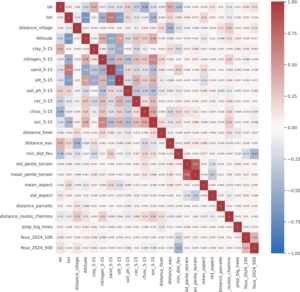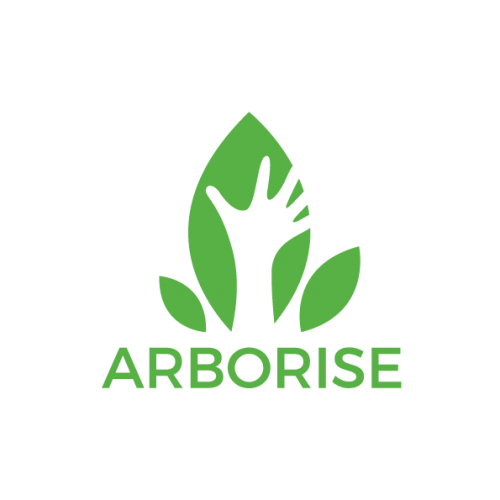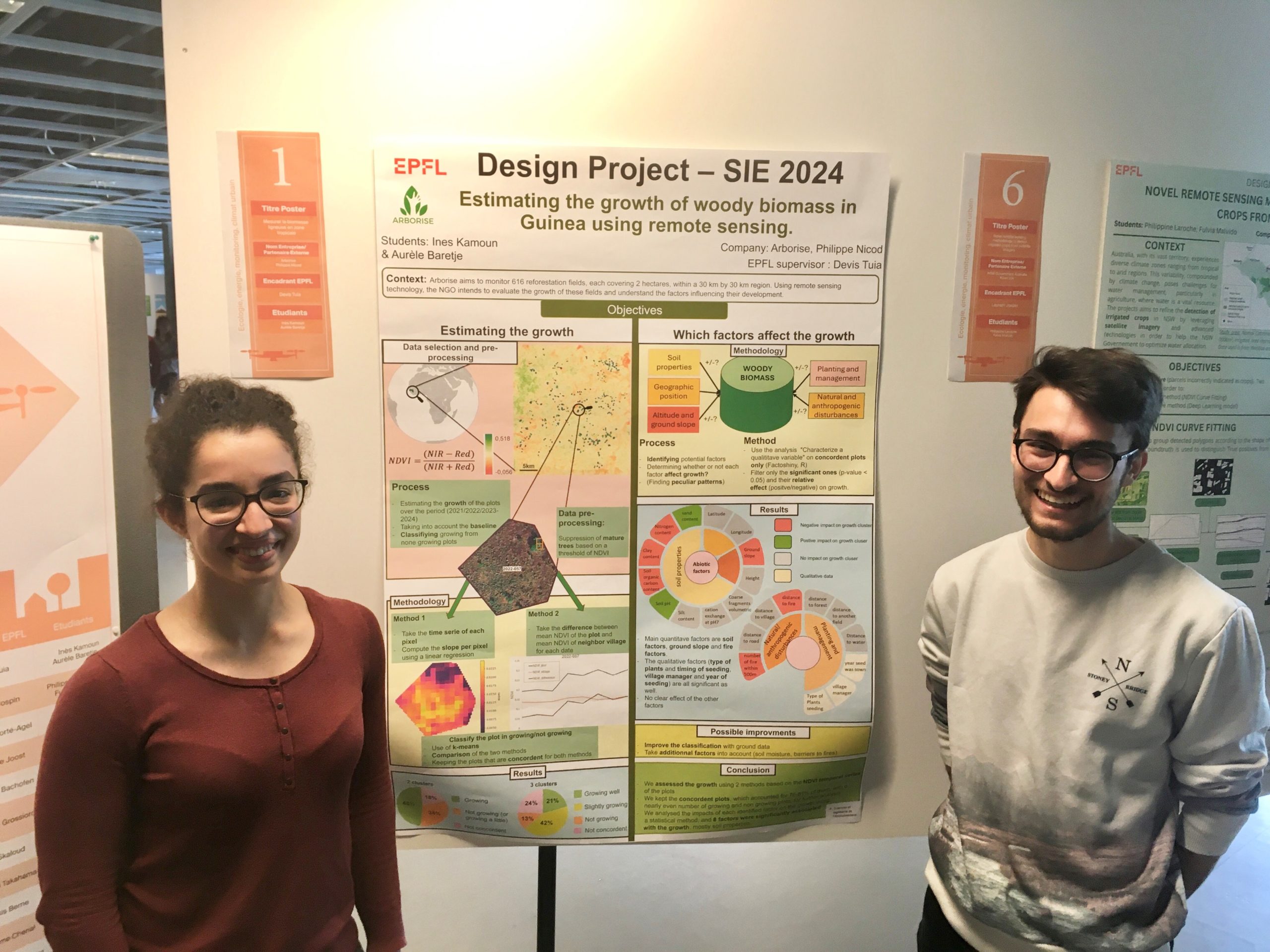Which natural and anthropogenic factors influence tree growth on land reforested by arboRise? To find out, we were lucky enough to have our research project selected by EPFL as part of the Design Projects course. In this compulsory course, master’s students in the ENAC department are responsible for providing scientific answers to problems posed by companies, local authorities and others. This applied research represents around 500 hours of work for each pair, so it’s a real scientific analysis, supervised by EPFL professors.
Ines and Aurèle were immediately interested in our project, and we were lucky enough to benefit from their expertise for several months (around 2 days a week for 15 weeks). Thank you Ines, thank you Aurèle! Both are geoscientists, so they know all the tools of satellite analysis inside out. They were supervised by Professor Devis Tuia. Ines and Aurèle’s report is a mine of information. It can be consulted in detail here: 240607_EPFL Design Project – Final Report.
First, they had to divide the land we reforested from 2021 to 2023 into several categories (basically “good” and “bad” land) based on biomass growth since the seeding date and compared to reference “neutral” land. The data comes from the Sentinel 2 satellite, which arboRise has frequently used for its own analyses. Our two researchers chose to focus the analyses on the month of February (2021, 2022, 2023, 2024), at the height of the dry season, to avoid as far as possible the influence of herbaceous plants on the data.
In a second stage, the baseline (the trees present on the land prior to reforestation) was removed from the data, again to avoid any external influence on the project.


Thirdly, a large number of other data – all potential anthropogenic or natural influencing factors – were collected via various satellites: slope, exposure, altitude, soil type, distance to the nearest village, roads, watercourses, bush fires, etc. The correlations between these potential influencing factors enable us to formulate numerous hypotheses and gain a better understanding of our perimeter’s geography. Correlations between these potential influencing factors allow us to formulate numerous hypotheses and better understand the geography of our perimeter. For example:
- There is a correlation between longitude (West-East) and altitude, and this is normal: the Simandou chain of hills that borders our perimeter to the West is higher than the bed of the Dion River that borders our region to the East, so our region “leans” towards the East.
- The average slope of our land is therefore logically steeper to the west, close to the Simandou, which is more rugged. It’s therefore normal that the distance between our plots is greater there than in the flatter areas to the east, where it’s easy to group plots together. Logically, roads tend to lie to the east, so the proximity of our lots to roads is greater to the east of the perimeter.
- We can also see that the nature of the soil changes according to altitude: soils are more clayey in the West and sandier in the East, since runoff flows from West to East.
- There are also strong, logical correlations between all the factors linked to soil type: nitrogen and organic carbon levels, soil ph, size of fractions and so on.


Finally, fourthly, Aurele and Ines statistically measured the degree of influence of each factor on the growth of terrain categories (e.g.: do all “good” terrains rise in altitude more than all “bad” terrains?). Here, only statistically significant influences are presented:
- First, there’s the influence of soil type. Sandy soils with a ph close to neutral are more conducive to growth. Surprisingly, we would have expected soils richer in clay, which retain water better, to be more favorable. Also surprising is the fact that nitrogen and organic carbon richness tend to be found in “bad” soils, even though these factors generally favor plant growth.
- Slope clearly has a negative impact on growth, certainly due to rainwater runoff (water stays on the ground for less time, taking nutrients with it), especially on low baseline sites (baseline: the vegetation existing on the site at the time of seeding). This seems logical: vegetation on the site slows down water runoff. It may also be explained by the fact that grazing fires are lit at the bottom of the slopes, which are more likely to climb the slopes than flat terrain.
- South-facing land is favorable, since the sunlight favors photosynthesis.
- Proximity to watercourses and fires is negative. Interestingly, only recent fires (2024) have had a visible impact. Fires in 2021, 2022 and 2023 do not stand out as an influencing factor, probably because trees regenerate quickly after being hit by a fire. It is grazing fires in particular (which stimulate the germination of young grass shoots that livestock are fond of), set in the vicinity of watercourses, that sometimes affect reforested land.
- Interestingly, distance from the nearest village or distance from tracks and paths had no influence on biomass growth.
- The year of planting also has an impact. This may be due to the arboRise methods, which have been perfected over time, or to the rainfall, which varies from year to year.
- There seems to be better growth in plots whose seeds are harvested and sown just before the rainy season. Whether this is linked to the species sown in this group or to the wetter period remains unclear.
- Finally, it seems that young trees grow better where the “baseline” is low. This may be an effect of natural competition: existing vegetation occupies the land, absorbing water and reducing sunlight.
Generally speaking, with the exception of recent fires, it seems that it’s mainly natural factors that influence tree growth. Of course, it is possible to identify villages on whose land trees grow better than in other villages, but this is probably due more to natural factors (soil type, slope, exposure, etc.), as the “unsuitable” villages tend to be located to the west in a hilly area.
These results are therefore very useful in determining the choice of future sites, where slopes should be avoided, especially along watercourses, and land with a lot of existing vegetation should be avoided.
A huge THANK YOU to Aurèle and Ines, who were truly passionate about the subject, and to Devis Tuia, who was kind enough to choose our research project. As with ETHZ, thanks also to EPFL for providing high-quality scientific expertise to organizations such as arboRise.

